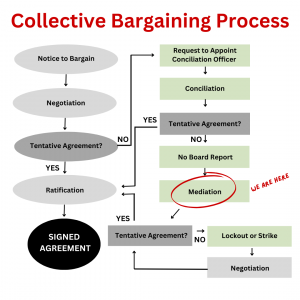FAQs

Negotiations with the Employer are ongoing. To keep up-to-date visit the CUASA website and watch your email.
On Thursday April 10th , after 5 full days of conciliation, CUASA asked the conciliator to notify the Ministry of Labour that an agreement could not be reached with the Employer. CUASA and the Employer received a written no-board notice from the Ministry on Thursday April 17th. The release of the no-board notice begins the countdown to the date on which either CUASA or the Employer can legally begin work stoppages including a lockout or strike. .
A no-board report is a step commonly taken in collective bargaining and does not necessarily result in work stoppages. CUASA and the Employer have signed collective agreements after the issue of a no-board in 2006 and 2010. Both parties continue to have a duty to bargain in good faith and attempt to reach a collective agreement.
CUASA and the Employer have committed to mediation dates with William Kaplan on April 26th and 27th. Mediation is a normal step in the bargaining process. CUASA’s Negotiating Team remains hopeful that the Employer will come to the table with fair and equitable offers on the few outstanding articles.
Conciliation and mediation are processes of bargaining that happen when two parties cannot come to agreement at the bargaining table.
Conciliation is a process by which a conciliation officer is appointed by the Ontario Minister of Labour, Immigration, Training and Skills Development to meet with unions and employers to attempt to help them resolve their differences. Conciliation is required by the Ontario Labour Relations Act before a lockout/strike position becomes legal. Ontario Labour Relations Act
Mediation is not legally required but happens when the two sides voluntarily agree to engage a mediator. A mediator (often the same person as the conciliator) takes a more active role in negotiations, suggesting possible ways to settle the issues in dispute.
Neither a conciliator nor a mediator has the power to impose a settlement.
A conciliator has been appointed by the Ministry, we expect them to contact both sides with available dates soon. In the interim CUASA’s Negotiating Team is committed to working towards agreement at the bargaining table. The conciliation process lasts as long as both parties are willing to sit at the bargaining table negotiating in good faith.
If CUASA and the Employer don’t reach an agreement during conciliation, the conciliation officer will report the outcome to the Minister of Labour, Immigration, Training and Skills Development and the minister will send a written notice to CUASA and the Employer. The report, commonly known as a “no-board” notice, begins the 17-day countdown to the date on which either the Employer or CUASA can begin a legal work stoppage – by a lockout or a strike respectively.
The release of a no-board report does not stop the processes of negotiation at the table.
Once the 17-day period after a no-board notification has passed (see above) the Employer is in a legal lockout position. Once in a legal lockout position, the Employer can impose new terms and conditions of work as the 2021/2024 collective agreement will no longer be in effect, and a new collective agreement will not be negotiated. In a lockout the Employer can deny CUASA members access to the workplace, campus, their email, university virtual platforms such as Brightspace, and importantly can stop paying members.
All of these actions are legal means to pressure CUASA members to settle on the Employer’s terms.
If a successful strike vote has not been taken CUASA members will not be able to strike in response to these moves by the Employer. (see “What is a strike? below)
The Employer can also ask the Ministry of Labour to conduct a supervised final offer vote (i.e. forced ratification vote), which would require the CUASA membership to vote on the Employer’s final offer, whether or not the Negotiating Team and/or Council thinks it is a good offer to present to members. The Employer can only call for a such a vote once.
CUASA members are in a legal strike position after no-board report has been issued and a successful strike mandate has been held by the membership.
If negotiations reach an impasse and a fair and equitable deal cannot be reached at the bargaining table the Negotiating Team would ask CUASA Council to consider strike actions. A strike can only be started (and stopped) by a majority vote of Council. (Bylaw 3)
During a strike it is key to withdraw as much of our labour as possible to motivate the Employer to negotiate and offer a fair deal. This withdrawal of labour includes regular job duties (teaching, grading, supervision of students and employees), service to the university (committees, administration), and as much peripheral research activity as possible.
All of these actions are legal means to pressure the Employer to settle on CUASA members’ terms.
During a strike CUASA members must impede the function of the university as much as it is legal, safe and ethical to do so.
On January 30th in accordance with Bylaw 3 (Strike Votes and Strikes) the unit representatives at CUASA Council, on the advice of the Negotiating Team, voted to bring a strike vote to the membership.
The strike vote will ask CUASA members whether they will give Council on the advice of the Negotiating Team the authority to call a strike if and when they decide it is absolutely necessary. A majority vote of the membership results in what is known as a strike mandate. Once a strike mandate is given by the membership Bylaw 3 dictates that the start and end of any strike is determined by a majority vote of Council, normally upon the advice of the Negotiating Team.
A strike mandate is necessary to send a strong signal to the Employer that CUASA members support their Negotiating Team. It also makes clear to conciliators and mediators that CUASA members arecommitted to arriving at a fair and equitable settlement that specifically addresses ongoing work issues and that they are willing to engage in actions to win a positive collective agreement.
A strike vote is a negotiating tool to put the maximum pressure on the Employer.
Strike votes are very common. Faculty associations across the country and in Ontario have asked for (and received) strike mandates in support of their Negotiation Teams.
Recently faculty associations at Guelph (UGFA) and the University of Ottawa (AUPO) reached tentative collective agreements after receiving strike mandates from their memberships.
The last time CUASA held a vote for a strike mandate was in 2018.
All members of CUASA’s bargaining unit are eligible to vote for (or against) giving the Negotiating Team a strike mandate.
No. A strike vote is NOT a vote to go out on strike. Nor does it mean a halt to negotiations. A strike vote simply gives the Negotiating Team a strike mandate.
(See What is a strike mandate and why does CUASA need one? above)
A high turnout and a high percentage of CUASA members voting in favour of a strike mandate is the best way to secure a fair and equitable collective agreement without a strike. The stronger the vote, the less likely a strike may be.
The timing of a strike vote is important. Failure to get a strike mandate could dramatically affect how seriously the Employer takes CUASA’s position at the bargaining table. The more reluctant CUASA members appear to be willing to strike, the greater the chance that the Negotiating Team will have to make significant concessions at the bargaining table.
Further, it is important that both the conciliator and the mediator aiding in the negotiations understand that the Negotiating Team has the support of CUASA members.
Without a strike mandate the Employer has significantly less incentive to offer CUASA’s team terms that meet our members’ interests and priorities.
The vote on a strike mandate will be held by secret electronic vote over a 48-hour period.
A strike vote is tentatively set for the last week of February. In advance of the vote the Negotiating Team will hold three virtual Information Sessions on
Tuesday, February 11th – 10:00 am to 11:30 am
Wednesday, February 12th – 2:00 pm to 3:30 pm
Monday, February 24th – Noon to 1:30 pm
All eligible CUASA members will receive an email with instructions on how to vote in the electronic ballot well in advance of the vote.
No. Negotiations are ongoing as are processes of conciliation and mediation. Even after a no-board report is issued as long as both sides agree, bargaining will continue. It is the intention of both the Negotiating Team and Council to continue bargaining in good faith if or when CUASA members vote for a strike mandate. In fact, having a strike mandate helps the bargaining process as it creates additional pressure to find a settlement acceptable to both sides.
A lockout or strike can be called 17 calendar days after the no-board report is issued.
While legal strike can begin 17 calendar days after a no-board report and after a positive strike mandate vote no strike start date is anticipated by CUASA at this time.
Measures currently undertaken by CUASA including the request for a conciliator, planned mediation and the strike vote are all in systematic and thorough efforts to avoid a strike.
Even with a positive strike mandate, a vote of Council will be necessary for a strike to begin (Bylaw 3).
The length of a strike is something we cannot predict. It depends on a number of factors including the strength of CUASA’s strike efforts and how much pressure members can collectively put on the Employer to settle. The longer a strike lasts, the more CUASA members will have to weigh the costs of staying out versus the costs of returning to work with a settlement that may not meet CUASA’s bargaining mandate as set by members.
CUASA Council, in consultation with the Negotiating Team, decides when to discontinue a strike action once it has started; this will always be determined in consultation with the membership.
CUASA needs reliable contact information for its members in the event of a lockout or a strike to communicate effectively, coordinate actions and deal with issues processing strike pay.
Although the Employer has not blocked CUASA members’ email in the past, there is no guarantee they won’t in the future. CUASA must ensure that we are able to communicate with members.
This FAQ will be updated regularly as negotiations continue. We will announce updates in the Bargaining Updates sent to your email box regularly. If you have any questions not answered here please contact your Council Representative or email us at [email protected].




